Swedish Air Force
| Swedish Air Force | |
|---|---|
| Flygvapnet | |
 Coat of arms of the Swedish Air Force | |
| Founded | 1 July 1926 |
| Country | |
| Type | Air force |
| Role | Aerial warfare |
| Size | 2,700[1] |
| Part of | Swedish Armed Forces |
| March |
|
| Equipment | 207 aircraft |
| Engagements | |
| Commanders | |
| Chief of Air Force | MajGen Jonas Wikman |
| Deputy Chief of Air Force | BGen Tommy Petersson |
| Chief of the Air Staff | Col Dennis Hedström |
| Notable commanders | Bengt Nordenskiöld |
| Insignia | |
| Roundel |   |
| Aircraft flown | |
| Electronic warfare | Saab 340 AEW&C, Gulfstream IV-SP |
| Fighter | JAS 39 Gripen |
| Helicopter | A109LUH, NH90, UH-60M |
| Trainer | Grob G 120TP |
| Transport | C-130H Hercules, Saab 340B, Gulfstream IV-SP, Gulfstream G550 |
The Swedish Air Force (Swedish: Svenska flygvapnet or just Flygvapnet) is the air force branch of the Swedish Armed Forces.
History
[edit]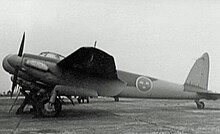
The Swedish Air Force was created on 1 July 1926 when the aircraft units of the Army and Navy were merged. Because of the escalating international tension during the 1930s the Air Force was reorganized and expanded from four to seven squadrons.
World War II
[edit]When World War II broke out in 1939 further expansion was initiated and this substantial expansion was not finished until the end of the war. Although Sweden never entered the war, a large air force was considered necessary to ward off the threat of invasion and to resist pressure through military threats from the great powers. By 1945 the Swedish Air Force had over 800 combat-ready aircraft, including 15 fighter divisions.
A major problem for the Swedish Air Force during World War II was the lack of fuel. Sweden was surrounded by countries at war and could not rely on imported oil. Instead domestic oil shale was heated to produce the needed petrol.[3]
About 250 aircrew were killed in crashes 1939-1945 according to statistics that were not disclosed during the war years but published afterwards.[4]
Expansion during the Cold War
[edit]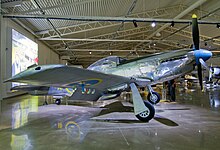
The Swedish Air Force underwent a rapid modernization from 1945. It was no longer politically acceptable to equip it with second-rate aircraft types. Instead, the Air Staff purchased the best it could find from abroad, e.g. P-51D Mustangs, De Havilland Mosquito NF.19 night fighters and de Havilland Vampires, and supported the development of top performance domestic models. The Saab 29 Tunnan jet fighter was introduced around 1950.
In the late 1950s the Swedish Air Force introduced the Bas 60 air base system, which revolved around force dispersal of air squadrons across many wartime air bases in case of war in order to make it complicated for an opponent to destroy the air force on the ground. Road runways were also introduced as backup runways. Bas 60 was developed further into Bas 90 during the 1970s and 1980s.[5][6][7][8]
During the Cold War large amounts of money (including funds intended for the Swedish nuclear weapons programme) were spent on the Swedish Air Force and domestic aircraft production. In 1957 Sweden had the world's fourth most powerful air force,[9] with about 1,000 modern planes in front-line service.[10] During the 1950s, it introduced fighters such as the Saab J 29 Tunnan, Saab A 32 Lansen and Saab J 35 Draken.[citation needed]
In June 1952 the Swedish Air Force lost two aircraft on Cold War operations, in what became known as the Catalina affair. A signals intelligence Douglas DC-3 was intercepted by Soviet MiG-15s over the Baltic, and shot down with the loss of three aircrew and five civilian technicians. A PBY Catalina rescue seaplane was then also downed, the five-man crew being rescued from the sea by a freighter.[citation needed]
In the air defence role the Swedish Air Force also operated surface-to-air missiles. Svea Air Corps (F 8) operated de Havilland J-28B Vampire jet aircraft in 1949 being replaced in 1953 by Saab J-29 Tunnan and in 1957 by J-34 Hunter fighters. As of 1961 F 8 reroled into missile defence role becoming the air force technical training centre for using the new RB-68 Bloodhound systems in 2 squadrons until 1974.
These Swedish units also operated the RB-68 missile system (1 squadron each):
- Scania Wing, also F 10 Ängelholm
- Kalmar Wing, also F 12 Kalmar,
- Bråvalla Wing, also F 13 Norrköping
- Blekinge Wing, also F 17 Kallinge,
Death toll during the Cold War
[edit]In the Cold War era, more than 600 Swedish fighter pilots were killed in crashes during peacetime exercises and training in the 1945–1991 period.[11] In the 1950s–60s era the flight training curriculum was deficient and the training regimes were too risky and some aircraft types had design flaws. In the 1950s, about 21 pilots were killed annually.[12]
In the 1960s the average number of killed were 13 per year, which meant Sweden had sixfold mortality rate per 100,000 flight hours compared to the United States. In the 1960s flight safety started to become a consideration, not due to the death toll but because the aircraft were getting increasingly expensive.[12] In October 1960, a Lansen fighter crashed into a farmhouse and killed 7 people.[4] In the 1970s the death toll was reduced to 6–7 per year. In subsequent years, it continued to fall and from 1996 onwards, no fatal accident has been recorded.[12]
War service
[edit]The Swedish Air Force has been involved in three wars, the Finno-Soviet Winter War in 1939–40, in which volunteers took part, the Congo Crisis, 1961–64, and in the 2011 Libyan civil war.
Finland 1940
[edit]When the Soviet Union attacked Finland in November 1939, Sweden came to its neighbour's assistance but eventually decided not to join the war.
A Swedish volunteer infantry brigade and a volunteer air squadron fought in northern Finland from January to March 1940. The squadron was designated F 19 and consisted of 12 Gloster Gladiator fighters and four Hawker Hart dive-bombers.
Congo 1961–1964
[edit]
The Swedish Air Force saw combat as part of the United Nations peace-keeping mission ONUC during the Congo Crisis in 1961 to 1964. It established a separate air wing, F 22, equipped with a dozen Saab 29 Tunnans, which performed well under the rough conditions in central Africa. The secessionist adversaries possessed only a small number of aircraft with poor combat capabilities, e.g. Fouga Magister trainers.
1990s – restructuring
[edit]With the end of the Cold War the Swedish Armed Forces underwent a massive restructuring process. During this time, several air bases were deemed unnecessary and closed with fighters like the Saab 37 Viggen retired prematurely. In 1994 the air force had over 400 fighters, by 2005 the number had sunk to fewer than 150.
Libya 2011
[edit]On 29 March 2011, the Swedish prime minister announced that eight Saab JAS 39 Gripens would support the UN-mandated no-fly zone over Libya.[13] The announcement responded to a NATO request for assistance. The Swedish fighters were limited to supporting the no-fly zone and were not authorized to engage in ground attack sorties. The deployment was approved by the Swedish Riksdag on 1 April 2011 and the first jets departed for Libya on 2 April. A C-130 Hercules accompanied the fighters for mid-air refueling.[14]
Equipment
[edit]Aircraft
[edit]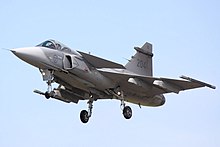
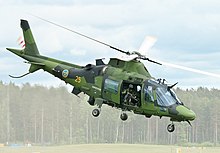
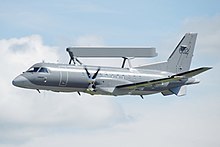
| Aircraft | Origin | Type | Variant | In service | Notes |
|---|---|---|---|---|---|
| Combat aircraft | |||||
| JAS 39 Gripen | Sweden | Multirole | JAS 39C
JAS 39D JAS 39E |
71[15]
23[15] 3 (60)[16] |
60 E variants on order
24 Gripen A/B in storage 120 C/D/E units are projected to be operational.[17] |
| AWACS | |||||
| Saab 340 | Sweden | AEW&C | ASC 890 | 2[18] | Equipped with the Erieye radar. |
| Bombardier Global 6000 | Canada | AEW&C | GlobalEye | 0 (+3) | 3 on order to replace ASC 890.[21][22] |
| Tanker | |||||
| KC-130 Hercules | United States | Aerial refueling | KC-130H | 1[18] | |
| Transport | |||||
| Saab 340 | Sweden | Utility transport | 1[18] | One used for reconnaissance | |
| Gulfstream IV | United States | VIP transport | 4[23] | Two aircraft used for SIGINT[18] | |
| C-130 Hercules | United States | Tactical airlifter | C-130H | 5[18] | |
| Helicopters | |||||
| Sikorsky UH-60 | United States | Utility | UH-60M | 15 (+12) | 12 UH-60M on order[24] |
| NHIndustries NH90 | European Union | Utility / Transport | TTH | 18[18] | To be phased out and replaced by UH-60M |
| AgustaWestland AW109 | Italy | Trainer / Light utility | 20[18] | ||
| Trainer aircraft | |||||
| Grob G 120TP | Germany | Basic trainer | 10 (+3) | Additional 3 on order in 2024, to be delivered by 2025. | |
| UAV | |||||
| AAI RQ-7 Shadow | United States | Surveillance | 8[25] | ||
| Elbit Skylark[26] | Israel | Surveillance | |||
Note: Three C-17 Globemaster III's are available through the Heavy Airlift Wing based in Hungary[27]
Weapons
[edit]Organization
[edit]Fighter wings
[edit]There are four fighter wings:
- Skaraborg Wing (F 7), at Såtenäs Air Base, operates JAS 39C/D[28]
- Uppland Wing (F 16), at Ärna Air Base, reestablished in 2021 and without fighter divisions as of 2024[29]
- Blekinge Wing (F 17), at Ronneby Air Base, operates JAS 39C/D
- Norrbotten Wing (F 21), at Luleå Air Base, operates JAS 39C/D
Helicopter squadrons
[edit]The aviation units that were formerly under the Swedish Army ("Arméflyget") and the Swedish Navy ("Marinflyget") have been merged with the helicopter units of the Air Force to form the single Helicopter Wing (Hkpflj) for the entire Armed Forces. The wing has been placed under the authority of the Air Force and consists of:
- 1st Helicopter Squadron, co-located with Norrbotten Wing at Luleå Air Base, operates NH90 TTH (Hkp 14)
- 2nd Helicopter Squadron, at Malmen Air Base, operates AW109 (Hkp 15) and UH-60M Black Hawk (Hkp 16)
- 3rd Helicopter Squadron, co-located with Blekinge Wing at Ronneby Air Base, operates NH90 TTH (Hkp 14) and AW109 (Hkp 15)
- 4th Helicopter Squadron, at Malmen Air Base, operates AW109 (Hkp 15) and UH-60M Black Hawk (Hkp 16)
Other squadrons
[edit]The air transport units perform airlift operations, and are used in both national and in international missions. The unit also organizes the Swedish part of the Heavy Airlift Wing in Hungary. Signals reconnaissance units conduct electronic combat reconnaissance and intelligence gathering.
- 71st Air Transport Squadron, co-located with Skaraborg Wing at Såtenäs Air Base, operates C-130H Hercules
- 74th Special Air Squadron, at Malmen Air Base, operates Gulfstream IV-SP, Saab 340 AEW&C and Saab 340
- 75th State Air Squadron, at Arlanda Air Base, operates Gulfstream IV
Future of the Swedish Air Force
[edit]
The Swedish Air Force is being adapted to new future tasks. Today about 80 Gripen C/D fighters remain in service. Some orders have been made and 60 new Jas 39 Gripen E units will join the air force in the coming years. Saab has also joined the primarily French project for the unmanned future stealth plane Dassault nEUROn.
In 2008 and 2010, the Swedish armed forces wanted to retire even more fighters and close air bases to relocate money to other branches. However, because of negative response from the public and pressure from the Swedish government, no cuts happened as of 2011.[30][31][32][33]
In 2013, the USMC introduced Swedish helicopter units to the forward air control airborne mission profile for better air-ground coordination.[34] In the same year, 60 further modified E class Gripens were ordered with the first plane to join the Air force in 2018.[35]
At RIAT 2022, the commander of the Swedish Air Force stated that the air force in the future (2030) will consist of 60 Jas 39C/D and 60 Jas 39E in a total of 7 fighter squadrons.
In November 2022, the Strategic Defence Plan was published in which it was announced that all NH90 helicopters will be phased out and replaced, additional Sikorsky Black Hawks will be ordered for the tactical transport role, a new medium sized helicopter for the ASW/ASuW role will be selected.[36]
Saab JAS 39 Gripen E
[edit]Today the Swedish Air Force main fighter is the Saab JAS 39 Gripen, in the C/D versions. By 2018 95 fighters were active with about 30 of these being updated from the A version.[37]
The heavily modernised E version will replace the current fleet of Gripen Cs. The new aircraft includes a new Active Electronically Scanned Array (AESA) radar, and is powered by the General Electric F414G. It carries more fuel and weapons. The upgrade also includes new weapon systems like the Meteor missile system.[38] In 2013, Saab signed an agreement with the Swedish Defence Materiel Administration for 60 new Gripen in the E version. The first aircraft is to join the Swedish Air Force by 2018.[39] JAS 39C is expected to remain in service until 2030.[40]

Military transport aircraft
[edit]The Swedish C-130 Hercules (TP 84) were bought from the United States in the 1960s and has been updated several times. The Swedish Defence Materiel Administration has been tasked to update the aircraft so they can remain in service to 2030. There are also plans to buy new aircraft by 2024 to replace the current fleet.[41] As part of the Heavy Airlift Wing cooperation, Sweden also operates three Boeing C-17 which are located at Pápa Air Base in Hungary.
Training aircraft
[edit]Sweden used the Saab 105 as the primary jet-trainer until phase out per June 2024. About 40 planes were operational. Designed in the 1960s the aircraft is starting to show its age and were gradually phased out from active service. The Swedish Air Force has selected the Grob G 120TP as its new Basic Trainer Aircraft, designated SK 40. 10 aircraft have been ordered and delivered but due to work environment problems caused by high workload the implementation of the new planes have been put on hold temporarily.[42]
Saab GlobalEye AEW&C
[edit]Sweden will procure the Saab GlobalEye airborne early warning and control (AEW&C) platform to replace its two S100D/ASC890. The Swedish Armed Forces submitted an official request to the government to buy the Saab GlobalEye platform on October 1, 2021. On October 24, 2021 the Swedish government approved the purchase to replace its old S100D/ASC890.
On 30 June 2022 SAAB and the Swedish Defence Materiel Administration (FMV) signed a contract for the acquisition of 2 GlobalEye aircraft, to be designated S 106 in Swedish service. The deal is valued at 7,3 billion SEK (US$710 million) and deliveries are scheduled for 2027. The contract also includes the option to procure up to 2 additional GlobalEye aircraft.
Ranks
[edit]- Commissioned officer ranks
The rank insignia of commissioned officers.
| NATO code | OF-10 | OF-9 | OF-8 | OF-7 | OF-6 | OF-5 | OF-4 | OF-3 | OF-2 | OF-1 | ||||||||||||||
|---|---|---|---|---|---|---|---|---|---|---|---|---|---|---|---|---|---|---|---|---|---|---|---|---|

|

|

|

|

|

|

|

|

|

| |||||||||||||||
| General | Generallöjtnant | Generalmajor | Brigadgeneral | Överste | Överstelöjtnant | Major | Kapten | Löjtnant | Fänrik | |||||||||||||||
- Other ranks
The rank insignia of non-commissioned officers and enlisted personnel.
| NATO code | OR-9 | OR-8 | OR-7 | OR-6 | OR-5 | OR-4 | OR-3 | OR-2 | OR-1 | |||||||||||||||||||||||||||
|---|---|---|---|---|---|---|---|---|---|---|---|---|---|---|---|---|---|---|---|---|---|---|---|---|---|---|---|---|---|---|---|---|---|---|---|---|

|

|

|

|

|

|

|

|

|

|

|

|

|

|

| ||||||||||||||||||||||
| Flottiljförvaltare | Förvaltare | Överfanjunkare | Fanjunkare | Översergeant | Sergeant | Överfurir | Furir | Korpral | Vicekorpral | Menig 4 | Menig 3 | Menig 2 | Menig 1 | Menig | ||||||||||||||||||||||
See also
[edit]- Chief of Air Force (Sweden)
- Royal Swedish Academy of War Sciences
- List of air forces
- List of military aircraft of Sweden
- Swedish Air Force Museum
- Swedish Air Force Historic Flight
People
[edit]References
[edit]- ^ IISS (2022). The Military Balance 2022. Routledge. p. 151. ISBN 978-1-032-27900-8.
- ^ Gyllenhaal, Lars. "I luftstrid över Lappland". Svenskt Militärhistoriskt Bibliotek (in Swedish). Archived from the original on 14 July 2013. Retrieved 11 December 2012.
- ^ Prien, Charles (1976). "Survey of Oil-Shale Research in the Last Three Decades". In Yen, T.F.; Chilingarian, George V. (eds.). Oil Shale. Amsterdam: Elsevier. p. 236. ISBN 0444414088.
- ^ a b "Svenska flygvapnets dödliga facit". Militarhistoria.se (in Swedish). 17 February 2018. Archived from the original on 15 December 2018. Retrieved 15 December 2018.
- ^ Rystedt, Jörgen (1 October 2005). "Flygbassystem 60" (PDF). Försvarets Historiska Telesamlingar (in Swedish). Archived (PDF) from the original on 4 March 2016.
- ^ Rystedt, Jörgen (25 April 2009). "Flygbassystem 90" (PDF). Försvarets Historiska Telesamlingar (in Swedish). Archived (PDF) from the original on 31 October 2017.
- ^ Törnell, Bernt (5 February 2007). "Svenska militära flygbaser" (PDF). Försvarsmakten (in Swedish). Archived (PDF) from the original on 3 June 2017.
- ^ Andersson, Lennart (23 November 2006). "Svenska reservvägbaser" (PDF). Försvarsmakten (in Swedish). Archived (PDF) from the original on 4 June 2017.
- ^ "The Growth of the Air Force". Flygvapenmuseum. 1 May 2010. Archived from the original on 14 March 2012. Retrieved 29 March 2011.
- ^ "Flygvapnet 80 år". Statens försvarshistoriska museer (in Swedish). Archived from the original on 18 March 2012.
- ^ "Pilotdöden – vårt okända nationella trauma". Vetenskapsradion Historia (in Swedish). 14 March 2013. Sveriges Radio. Archived from the original on 15 December 2018. Retrieved 15 December 2018.
- ^ a b c "Nu utreds massdöden inom flygvapnet". Expressen (in Swedish). 29 April 2013. Archived from the original on 15 December 2018. Retrieved 15 December 2018.
- ^ "Sweden plans to join Libya no-fly zone with fighter jets, but no ground attacks". Google News. Associated Press. 29 March 2011. Archived from the original on 2 April 2011. Retrieved 30 March 2011.
- ^ "Swedish Gripen Planes Headed to Libya". The Local. 2 April 2011. Archived from the original on 4 April 2011. Retrieved 2 April 2011.
- ^ a b Hoyle, Craig (2023). "World Air Forces 2024". Flightglobal Insight. Retrieved 12 December 2023.
- ^ "Leverans av det första serieproducerade JAS 39E-planet till FMV" [Delivery of the first series-produced JAS 39E aircraft to FMV] (in Swedish). Swedish Defence Materiel Administration. 2023-10-19. Archived from the original on 2024-07-13. Retrieved 2024-09-21.
- ^ Hoyle, Craig (2024-06-12). "Why Swedish Gripen fleet is NATO's new ACE off base". Flight Global. Archived from the original on 2024-07-20. Retrieved 2024-09-21.
- ^ a b c d e f g h Hoyle, Craig (2023). "World Air Forces 2024". Flightglobal Insight. Retrieved 12 December 2023.
- ^ Post, Kyiv (2024-05-29). "Sweden Sending Two Saab 340 AEWCS Sky and Sea Surveillance Planes to Ukrainian Air Force". Kyiv Post. Retrieved 2024-05-29.
- ^ Rogoway, Thomas Newdick, Tyler (2024-05-29). "Ukraine Getting Swedish Airborne Early Warning Radar Planes Is A Big Deal". The War Zone. Retrieved 2024-05-29.
{{cite web}}: CS1 maint: multiple names: authors list (link) - ^ "Saab signs contract with Swedish FMV for a third GlobalEye". Start. Retrieved 2024-06-28.
- ^ Regeringskansliet, Regeringen och (2024-05-29). "Military support package 16 to Ukraine – new capability to strengthen Ukraine's air defence and support to meet its prioritised needs". Regeringskansliet. Retrieved 2024-06-28.
- ^ "TP 100" (in Swedish). Retrieved 16 March 2020.
- ^ https://www.fmv.se/aktuellt--press/aktuella-handelser/bestallning-av-tolv-helikoptrar/ [bare URL]
- ^ "Materiel och teknik: UAV 3 Ornen". Försvarets materielverk (in Swedish). Archived from the original on 12 November 2011.
- ^ "Materiel och teknik Flyg: SUAV systemet Falken" [Goods and technology Flights]. Försvarets materielverk (in Swedish). Archived from the original on 5 July 2011.
- ^ "Heavy Airlift Wing". Strategic Airlift Capability Program. Retrieved 17 April 2020.
- ^ "Förband och förmågor: Julgran markerar slutet för en epok". Försvarsmakten (in Swedish). Archived from the original on 18 April 2013.
- ^ Olofsson, Kristoffer. "Upplands flygflottilj är tillbaka". Försvarsmakten.
- ^ "Kraftig minskning av antalet Jas-plan". Sveriges Television (in Swedish). 11 May 2008. Archived from the original on 23 March 2009.
- ^ "Ingen flygflottilj utpekad". Sveriges Television (in Swedish). 15 May 2008. Archived from the original on 23 March 2009.
- ^ "Inga nedläggningar av förband". Dagens Nyheter (in Swedish). 13 September 2008. Archived from the original on 6 February 2009. Retrieved 20 May 2015.
- ^ "Försvaret föreslår nya nedläggningar" [The defence proposes new closures]. Smålandsposten (in Swedish). 6 March 2010. Archived from the original on 2 April 2011. Retrieved 29 March 2011.
- ^ Vayavananda, Tatum (28 August 2013). "MAWTS-1 Marines introduce FAC(A) to Swedish Air Force". Marine Corps Forces Europe. Archived from the original on 30 August 2013.
- ^ "Klartecken ätt köpa nya JAS plan" [The go-ahead to buy new fighter, attack & reconnaissance planes]. Riksdag & Departement (in Swedish). 17 January 2013. Archived from the original on 3 May 2014. Retrieved 8 October 2014.
- ^ Perry, Dominic (2022-11-01). "Sweden to axe NH90 fleet under revised defence equipment plan". Flightglobal. Retrieved 2023-12-17.
- ^ Gummesson, Jonas (29 April 2015). "Vart tredje JAS-plan taget ur drift" [Every three JAS aircraft in service]. Svenska Dagbladet (in Swedish). Archived from the original on 17 August 2016. Retrieved 5 August 2016.
- ^ "Gripen E Multirole Fighter Aircraft". Air Force Technology. Archived from the original on 26 July 2016. Retrieved 5 August 2016.
- ^ "Saab signs agreement for the next generation fighter aircraft Gripen E and receives development order". Saab Group. 15 February 2013. Archived from the original on 21 August 2016. Retrieved 5 August 2016.
- ^ "Försvarsmaktens budgetunderlag för 2022" (PDF). Swedish Armed Forces. 2022.
- ^ Augustsson, Tomas (20 July 2016). "Flyg jättarna som kan lyfta svenska Försvaret" [Flights giants that can lift Swedish defence]. Svenska Dagbladet (in Swedish). Archived from the original on 3 August 2016. Retrieved 6 August 2016.
- ^ Sundgren, Linda (2023-04-14). "Akuta arbetsmiljöproblem på Flygskolan - införandet av SK 40 påverkas". Officerstidningen (in Swedish). Retrieved 2023-05-15.
- ^ a b "Försvarsmaktens Gradbeteckningar" (PDF). Försvarsmakten (in Swedish). Swedish Armed Forces. 2 January 2014. Retrieved 13 March 2024.
Further reading
[edit]- Annerfalk, Anders. Flygvapnet: An Illustrated History of the Swedish Air Force (Ljungsbro: Aviatic Förlag, 1999).
- Åselius, Gunnar. "Swedish strategic culture after 1945." Cooperation and Conflict 40.1 (2005): 25–44.
- Böhme, Klaus-Richard. The Growth of the Swedish Aircraft Industry: 1918-1945: the Swedish Air Force and Aircraft Industry (Sunflower University Press, 1988).
- Green, William and Gordon Swanborough. "The End of the Beginning...The Seversky P-35". Air Enthusiast, No. 10, July–September 1979, pp. 8–21. ISSN 0143-5450
- Owers, Colin (Spring 1994). "Fokker's Fifth: The C.V Multi-role Biplane". Air Enthusiast. No. 53. pp. 60–68. ISSN 0143-5450.
- Silvester, John. "Call to Arms: The Percival Sea Prince and Pembroke". Air Enthusiast, No. 55, Autumn 1994, pp. 56–61. ISSN 0143-5450
- Weibull, Alise. "The Swedish Armed Forces: Recent Developments and Future Strategy." in Giuseppe Caforio, ed., Cultural Differences between the Military and Parent Society in Democratic Countries (Emerald Group Publishing Limited, 2007) pp. 307–312.

